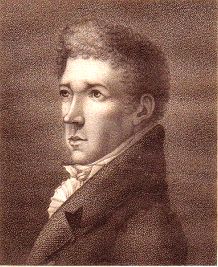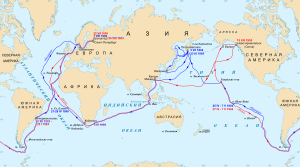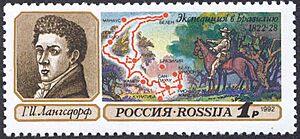Georg von Langsdorff facts for kids
Quick facts for kids
Georg Heinrich von Langsdorff
|
|
|---|---|
 |
|
| Born | 8 April 1774 Wöllstein, Electoral Palatinate, Holy Roman Empire
|
| Died | 9 June 1852 (aged 78) |
| Nationality | German |
| Scientific career | |
| Author abbrev. (botany) | Langsd. |
Georg Heinrich Freiherr von Langsdorff (born April 8, 1774 – died June 9, 1852) was a German scientist and explorer. He studied nature and was also a Russian diplomat. Many people knew him by his Russian name, Grigori Ivanovich Langsdorf.
He worked as a naturalist and doctor on the First Russian circumnavigation from 1803 to 1805. Later, Langsdorff became Russia's top diplomat, called a consul general, in Rio de Janeiro, Brazil. From there, he planned big trips to explore Brazil. These included expeditions to Minas Gerais (1813-1820) and the famous Langsdorff Expedition to the Amazon rainforest (1825-1829).
Contents
Life of Georg Langsdorff
Georg Heinrich Langsdorff was born in April 1774 in a place called Wöllstein. This was in the Electoral Palatinate, part of the Holy Roman Empire at that time. He went to the University of Göttingen in Germany. There, he studied medicine and natural history. He earned his doctor's degree in medicine and surgery in 1797.
In the same year, he traveled to Lisbon with Prince Christian August. After the prince died in 1798, Langsdorff started his own medical practice. He later became a surgeon for English soldiers in Portugal. After a peace treaty was signed, he visited London and Paris. Then, he returned to Göttingen.
On January 29, 1803, he became a member of the Russian Academy of Sciences. He wanted to join the first Russian trip around the world. At first, he was told no. But he quickly traveled to Copenhagen, where the ships were still docked. He convinced the ambassador and the captain to let him join.
Exploring the World: Russian Voyage
Langsdorff joined the Russian expedition led by Captain Krusenstern. He worked as a naturalist and doctor from 1803 to 1805. During this journey, he visited many places. These included Falmouth in England, Tenerife in the Canary Islands, and Santa Catarina Island in Brazil. He also saw Nuku Hiva, the Hawaiian Islands, Kamchatka Peninsula, and Japan.
When the expedition returned to Kamchatka, Langsdorff left the main group. He traveled with Ambassador Nikolai Rezanov to the northwest coast of North America. He explored the Aleutian Islands, Kodiak, and Sitka. From San Francisco, he sailed to Siberia. Then, he traveled overland to Saint Petersburg, arriving in 1808.
He faced many problems on his journey. In Brazil, his plant samples rotted because of the humidity. Ants also ate his insect collections. On his way back to Saint Petersburg, he lost some of his plant collection in the Lena River. Despite these challenges, he published his discoveries. One of his books was Plants collected during the Russians' voyage around the world. It was published in 1810.
Langsdorff in Brazil
In 1813, Langsdorff was appointed Russia's consul general in Rio de Janeiro, Brazil. He bought a farm called "Mandioca" (which means manioc). There, he collected plants, animals, and minerals. He welcomed other scientists and naturalists, like Johann Baptist von Spix. He also explored the plants, animals, and land of Minas Gerais with French naturalist Augustin Saint-Hilaire. This work lasted from 1813 to 1820.
The Great Langsdorff Expedition
In 1821, Langsdorff suggested a big scientific trip to Tsar Alexander I. The idea was to explore from São Paulo to Pará in the Amazon rainforest. The journey would mostly be by river. In March 1822, he returned to Rio with a team of scientists. These included Édouard Ménétries (zoology), Ludwig Riedel (botany), and Nester Rubtsov (astronomy and maps).
To record their findings, Baron Langsdorff hired painters. These were Hércules Florence, Johann Moritz Rugendas, and Adrien Taunay. The inventor of the bicycle, Karl von Drais, also joined the expedition.
After much planning, the Langsdorff Expedition started on June 22, 1826. Forty people and seven boats left Porto Feliz on the Tietê river. They reached Cuiabá on January 30, 1827. The expedition then split into two groups. Langsdorff and Florence's group reached Santarém on the Amazon River on July 1, 1828. They faced huge difficulties and suffering.
Many members of the expedition became sick with tropical fevers, likely yellow fever. Baron de Langsdorff also became ill and lost his mind in May 1828. Adrien Taunay drowned in the Guaporé River. Rugendas left the expedition early. So, only Florence stayed for the entire journey. The groups met again in Belém. They returned by ship to Rio de Janeiro, arriving on March 13, 1829. The trip had lasted almost three years and covered 6,000 kilometers.
Huge collections of scientific items were sent to the Kunstkamera museum. These later became the basis for South American collections in Russian museums. However, the expedition's detailed scientific records were lost for a century. They included many descriptions of animals, plants, minerals, and languages. Soviet researchers found them again in 1930.
Because of the hard journey, Langsdorff's team could not collect many biological samples. Most of their notes were about geography and the people they met. They were especially interested in the many indigenous people of Brazil. Many of these groups later disappeared. Today, much of the material is in museums in St. Petersburg.
Langsdorff returned to Europe soon after the Amazon expedition. He died in Freiburg im Breisgau, Germany, from typhus in 1852.
A recent study found that Langsdorff has 1,500 descendants in Brazil. One famous descendant is Luma de Oliveira, a Brazilian carnival queen.
Legacy of Langsdorff
A type of poisonous South American coral snake is named in his honor. It is called Micrurus langsdorffi.
Media about the Expedition
The Discovery Channel made a documentary film about the expedition. It features Adriana Florence, a descendant of Hércules Florence. The film retraces part of the expedition's journey. It also visits the Langsdorff museum collections in St. Petersburg. Mauricio Dias directed the film.
See also
 In Spanish: Georg Heinrich von Langsdorff para niños
In Spanish: Georg Heinrich von Langsdorff para niños




